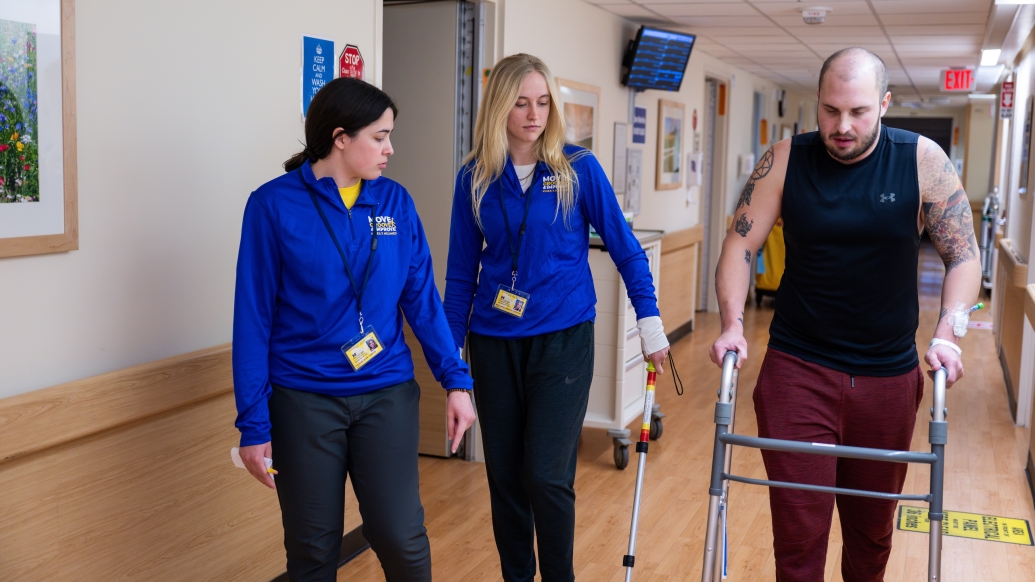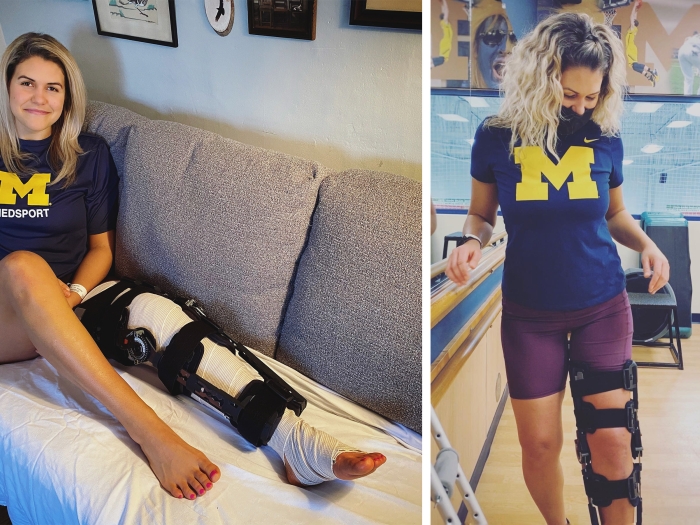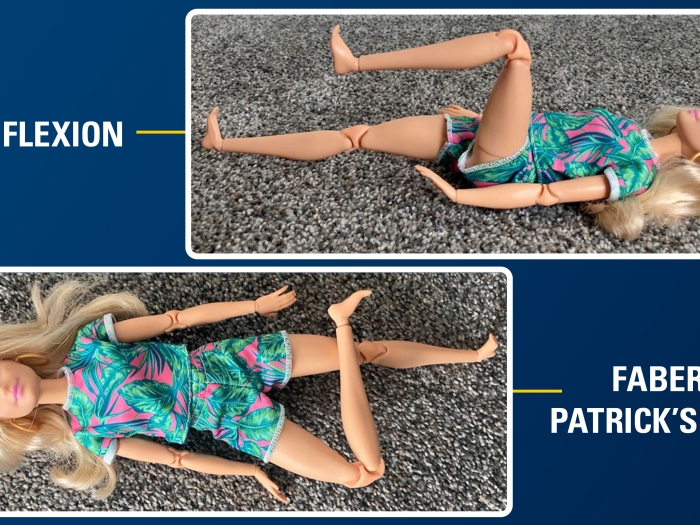A pilot partnership pairs kinesiology undergrads with hospital patients to keep them up and moving during their stay
5:00 AM
Author |

Movement science undergraduates, Therese Campos and Meghan Tompkins, were walking, like they do every Tuesday and Thursday between 3 and 7 p.m. Back and forth, back and forth, down the hallway of one of Michigan Medicine’s Medical Short-Stay Units.
The patient they were escorting was very excited to be up and about.
“I haven’t been out of my bed yet,” she told them. “I want to walk.”
“Awesome,” they said. “That’s what we’re here for.”
Specifically, Campos and Tompkins were at Michigan Medicine as part of the new Mobility Initiative. This pilot partnership between the University of Michigan’s health care system and the U-M School of Kinesiology aims to provide patient experience for students interested in health care careers while supplying Michigan Medicine with additional personnel who can assist with an important element of care.
The patients in the program aren’t often in the hospital for very long, two or three nights on average. But even in that short time, they can become less conditioned, which can lengthen their stays and sometimes even lead to other health concerns, like pressure sores or hospital-acquired infections.
“The initiative really started with a question,” said Chris Magnant, the former acute therapies director at Michigan Medicine. “‘How do we prevent patients from losing strength and mobility during their hospital admission?’”
The answer: Twice a week during the winter semester, Campos, Tompkins, and two other kinesiology students, Kaleb June and John Han, have headed over to the medical campus.
They introduce themselves and ask patients to get up and walk a short distance several times, accompanying them along the way to make sure they don’t fall.
“It’s pretty surface-level in terms of what we’re doing for them,” said June. “But I’m still proud of these people we just met and what they’re able to accomplish. It reaffirmed how much I want to be involved in health care in the future.”
***
This isn’t the first time Michigan Medicine has addressed mobility.
About seven years ago, the health system made a push in that direction, with different types of providers (nursing, physical therapy, occupational therapy, etc.), devising their own plans, Magnant says. For instance, a multidisciplinary group started a Safe Patient Handling and Mobility program that focused on critical care, making sure the sickest patients in the ICU were getting some level of movement.
It was around that time that Magnant came up with the idea for the Mobility Initiative, specifically thinking of partnering with students to supplement Michigan Medicine’s expertise.
“Why aren’t we tapping into all of the resources we have at a major university and combining those with the health care system to come up with a program that meets the needs of patients who are deemed safe to walk?” she wondered. “What better group to help with that than the students majoring in movement science?”
Given her leadership responsibilities back then, Magnant didn’t have the time to bring the initiative to fruition. But as she was getting ready to retire last year, she brought up some unfinished projects she felt compelled to continue working on, including what would become the Mobility Initiative. Her boss encouraged her to stay on in a limited capacity and see what she could make happen.
It was good timing. Michigan Medicine had recently joined a collaborative of academic medical centers to share data and lessons learned about mobility, with a plan to take lessons learned back to the hospital to make an impact. The impetus? The COVID-19 pandemic, which LaToya Freeman, director of quality safety and patient experience at Michigan Medicine, says was the “aha moment” for a lot of health care organizations when it came to the importance of mobility.
“Since then, patients are getting sicker,” Freeman said. “They’re staying longer in the hospital. For us, space was becoming an issue. The emergency department is still busting out of its seams. So trying to find ways to open up capacity as well as ways to decrease some of our hospital-acquired conditions that’s impacted by the deconditioning of our patients spearheaded a lot of mobility work at Michigan Medicine.”
***
With the health system on board, Magnant emailed Dean Lori Ploutz-Snyder and associate dean for undergraduate education Pete Bodary, asking if they’d be interested in a partnership. Within half an hour, Ploutz-Snyder had replied.
“I was enthusiastic about the idea right from the beginning,” Ploutz-Snyder said. “Some of my previous work with NASA included 70-day bed rest studies, so I know firsthand how much deconditioning occurs with bed rest. The combination of helping patients move more and helping our students gain valuable patient contact in a hospital setting is so mutually beneficial that it was easy to say yes to.”
Magnant started putting together a team to develop the program, which included Freeman but also incorporated input from groups ranging from ergonomics to medical educators to nursing supervisors.
The team chose the Medical Short-Stay Unit as the location for the pilot program because patients there don’t typically require as much skilled expertise to manage as those in most of the other inpatient units. The unit had also seen success with a recent program to reduce falls, and Freeman wanted to make sure the nurses didn’t focus so much on that element that they were disregarding mobility.
“Oftentimes, nurses say they don’t want their patients to fall so they don’t get them up,” Freeman said. “There’s a disconnect there.”
Bodary tapped Michele Bird, an applied exercise science clinical assistant professor who’d previously worked as a physical therapist at Michigan Medicine, to lead the program on the kinesiology side.
“My entire career has been about trying to ensure that people maintain their mobility,” Bird said. “That’s probably the number one reason why I became a physical therapist. And when I took on this full-time position as clinical assistant professor, I was leery about completely leaving my primary career. So, when I was approached to be a part of the Mobility Initiative, I was ecstatic that I could continue to keep my health care provider hat on, even though I’m not working directly with these patients.”
As Michigan Medicine worked out the operational logistics, Bodary and Bird sent call-outs to kinesiology undergraduate students explaining the project. About 80 were interested. Just four were selected, based on essays they wrote.
“We wanted to make sure we weren’t overwhelming the Short-Stay Unit or ourselves,” Bird explained, “and to ensure we get the processes down before we grow the program.”
Bird created objectives for the students, including developing communication and interpersonal skills in order to establish rapport with patients and the health care team; learning how to safely walk with patients and execute anything else the patient needed, like help getting out of bed; documenting and communicating the patients’ progress, and learning about common issues that might impair a patient’s mobility, such as muscle weakness and loss of balance.
The students would have to complete learning modules on different topics like empathy in health care and chronic disease on a weekly basis and meet with Bird a couple of times to talk about their experience and progress toward the personal goals they had set.
By January, all the pieces were in place. It was time to bring the students in.
***
The first thing the students always have to do when they arrive at the hospital is figure out who they can walk with that day.
The program uses the Johns Hopkins Highest Level of Mobility Scale as a guide. This tool assigns numbers to patients from 1 to 8, depending on how much they can move. If a patient is at a 1, for instance, they can only lay in bed; if they’re at a 3, they can sit on the edge of the bed. Patients deemed able to walk at least 10 steps are rated at a 6, and that’s the minimum level of ability the students can work with.
When the Mobility Initiative first started, however, the scale had just been introduced to the unit, and not all the nurses on the floor were familiar with it.
“We needed to have a lot more communication at the beginning,” Campos said.
Now, they’ve settled into a routine. June asks the nurse in charge of the floor for the list of patients who’ve been cleared to walk, and the other students confirm these patients with the bedside nurses.
Then it’s time to knock on doors, introduce themselves to patients, and get moving.
The students have to keep track of the time and distance the patients walk and how many times per day (they aim for three walks per patient within the four-hour period they’re at the hospital) and document how well the walk went and the patient’s reaction to the movement.
Unless the patients say no, they don’t want to walk.
Then the conversation turns to figuring out why. Is it because they’re waiting for their pain medication to kick in? Is it because they need mobility aids like a walker or a medical boot, which the students can assist with? Is it because the patient truly can’t walk very far, so they’re limited to their room instead of the hallway?
Or perhaps the patients don’t want to walk for the most common reason: They’re scared. Once, there were eight patients in the unit, but only four said yes to walking because they were afraid — leaving the students with little to do and the patients more immobile.
“Sometimes it takes some convincing,” Campos said. “Other times, we have to say, ‘OK, we'll be back in half an hour or an hour to check if you want to walk again.’ It’s going back and back and trying to help them understand that the nurses have cleared them to walk — and that they’ll feel better if they do.”
The persistence has been worth it.
The students can recount plenty of stories where wary patients were surprised at how long they could walk or were thrilled when they could walk longer than they did before. For instance, one patient who’d just had spine surgery was worried about walking given that she couldn’t sit upright. But she got out of bed and walked a distance of 64 feet (a 7 on the Johns Hopkins scale) twice. She was so excited that she called a loved one and recounted her triumphs.
“I was able to walk the circle twice!” the students heard her say.
Plenty are eager to walk — and often talk — with the students from the outset. Tompkins recalls one man who was speed walking and telling them jokes in the process. One woman told them her life story and was disappointed when they had to pass her off to someone else instead of walking with her again.
“Half of them walk around just to talk to us,” June said. “Just getting out of your room and walking around like you're not in a hospital room and stuck and talking to people who are just there to talk to you, I think it definitely makes people feel better. It makes you feel more normal while you're in the situation of being stuck in the hospital.”
***
So far, Freeman says, the feedback about the program from nursing staff, students, and patients has been “wonderful.”
“We’ve seen the students be impactful even with patients that may have some cognitive delays or mental challenges,” Freeman said. “They’ve been able to be companions for those people who may not have family at the bedside. And patients that have reported pain and hadn’t been up walking [before working with the students], we’ve seen a decrease in their pain ratings. It’s been great.”
“As someone who’s interested in going into physical therapy or occupational therapy, I want to see how rehabilitation can help patients improve,” Campos said. “So seeing how much better they feel when they’re walking is cool. But this experience has also reinforced that I like working with people, and that’s what I want to do in the future.”
Other hospital units have already asked what’s happening at the unit and how they can participate.
In one sense, everyone will be able to get more involved, thanks to the “Healing in Motion” mobility program Michigan Medicine launched in its adult hospitals in early April.
Trainers on each unit will help health care providers from various disciplines create common language to discuss mobility; implement new methods to assess mobility and set goals to achieve it; and, most importantly, encourage appropriate movement and walking for patients early and often throughout their hospital stays.
Freeman says she also plans to reconvene the team behind the Mobility Initiative in the summer and think about lessons learned and next steps, including how to expand the program given the level of interest.
“Seven years ago, mobility was just getting legs,” Magnant said. “It was just being pushed to the forefront of a need. Now the whole hospital has bought in.”

Explore a variety of health care news & stories by visiting the Health Lab home page for more articles.

Department of Communication at Michigan Medicine
Want top health & research news weekly? Sign up for Health Lab’s newsletters today!





